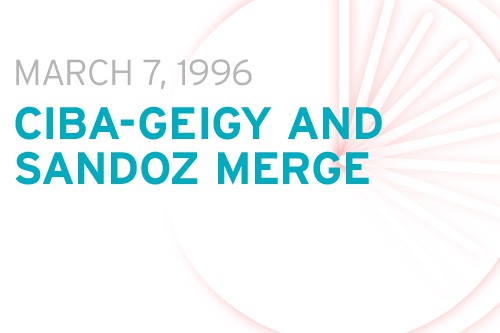
This column has dealt with the creation of several major modern pharma companies, from the megamerger of GlaxoWellcome and SmithKline Beecham to form GSK and the many tributaries that eventually converged to make up the French giant Sanofi.
Right up there with the very biggest is the £36bn merger between the Swiss companies Ciba-Geigy and Sandoz to create the behemoth that is Novartis.
Announced on March 7 1996, the deal was the largest of its kind at the time and was set to establish what would be the second biggest company after GlaxoWellcome, itself the subject of a multibillion pound merger just four years later.
The Novartis merger was said at the time to be part of a wave of consolidation as companies sought to cope with slower drug spending as healthcare systems tightened their budgets.
Speculating on the deal’s place in terms of the wider pharma environment Salomon Brothers analyst Peter Laing somewhat presciently told the Independent “consolidation in the industry hasn’t gone away and the pressure to cut costs hasn’t gone away. So I don’t think this will be the last”.
With the GlaxoWellcome merger coming not long after, not to mention Astra and Zeneca’s union and Pfizer’s acquisitions of Warner Lambert, Pharmacia and, more recently, Wyeth, Laing’s comments seem prophetic, although in hindsight, the strident success of Novartis and the others in the following years seems obvious.
In the case of Novartis, the combination Ciba-Geigy and Sandoz was a complementary one, with each business strong in its own area of the pharma market. Some analysts at the time also noted that Ciba-Geigy’s decision to pursue a deal may have been influenced by several hits to its pipeline, notably the decision to withdraw stroke treatment Selfotel and to pull blood clot drug Hirudin after trial disappointments.
As well as combining expertise, the merger also saw Ciba-Geigy and Sandoz commit to a new focus, with both companies selling off other assets to apply themselves to pharmaceuticals and agrochemicals.
And leading the newly formed Novartis was Ciba Geigy’s chairman, Alex Krauer, as chairman and Sandoz chief executive, Daniel Vasella, as CEO.
Despite only being born in 1996, Novartis history is a long one, however, with Mark Lesney describing the deal as the “final destination of three major historical pathways” in an issue of Modern Drug Discovery from 2004.
It’s a pathway that goes all the way back to 1758, when Swiss scientist Johann Rudolf Giegy-Gemuseus founded the chemical company JR Geigy in Basel.
The company focused initially on dyes, but started manufacturing healthcare products in the 19th century, eventually creating a pharma R&D department in 1938.
This led to its first major drug, the antirheumatic treatment Butazolidin, which was launched in 1949. Several other products, such as epilepsy drug Tegretol, followed over the next few decades until Geigy merged with Ciba in 1970 to form Ciba-Geigy.
Although quite as old as its eventual partners Ciba’s history stretches far back, when in 1859, Aexander Clavel – also the owner of a dye factory – began producing chemicals, including fuchsine.
With a functioning chemical production facility, Clavel was able to sell the dye factory to a company called Bindschedler & Busch who had a commercial presence beyond Switzerland.
In 1884 Bindschedler & Busch changed its name to Gesellschaft für Chemische Industrie Basel, which was abbreviated to the much more palatable Ciba, and this new company produced its first healthcare products in the early 20th century, including the antiseptic Vioform.
Ciba grew throughout the 20th century, creating more and more drugs, launching the likes of Desteral and Araldite before joining with Geigy.
Despite being almost 130 years old Sandoz is the baby of the bunch, having formed in 1886 under the initial name Kern & Sandoz by, yet again, two Swiss scientists in charge of a dye factory.
The company diversified over the following decades, however, producing sweeteners and eventually pharma products, with Professor Arthur Stoll establishing a department in 1917.
Successes over the 20th century included the antipsychotic Melleril and the immunosuppressant Sandimmun, which revolutionised transplantation.
These rich histories proved the right mix in the 1990s and the Novartis legacy continues to match its parents, with the company ranking second for global sales in the PMLiVE Top Pharma List.





